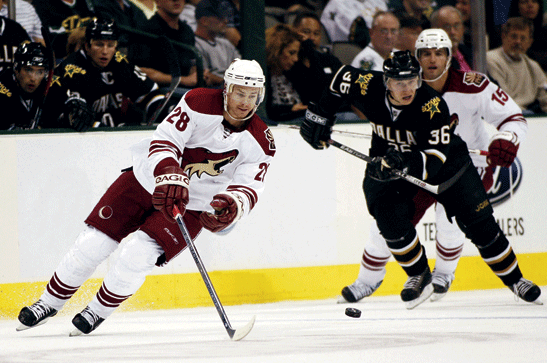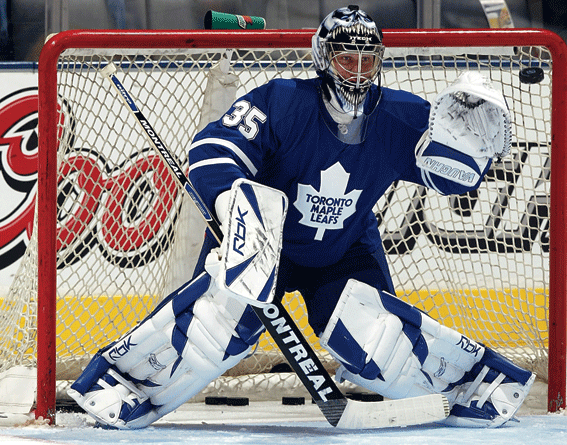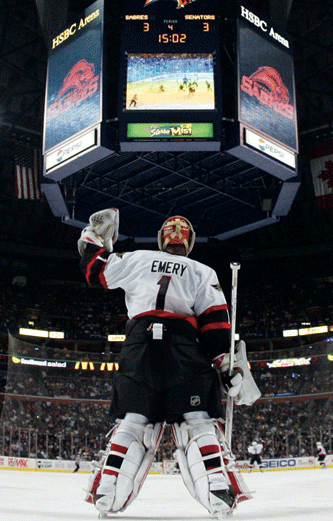
![]() Sports
Sports
Ice Hockey
A Combination of Grace and Brute Force 
Despite conflicting with “good manners” … Ice Hockey remains Canada’s favorite sport.
By Patrick Falby
What makes a Canadian? The country’s citizens often wring their hands when it comes to this topic. To the south, Americans have many myths and images (the land of opportunity, freedom, apple pie) that have helped foster their superpower culture. Some of the only defining characteristics of Canadians, however, are that they’re generally polite and not American.
But their reputation for good manners conflicts with the real defining Canadian characteristic: a hot passion ice hockey, the sport described by the late Canadian poet Al Purdy as the “combination of ballet and murder.”
Canada is the epicenter for this fast, physical game played on a rink. Most Canadians grow up playing the sport on frozen ponds, homemade rinks in backyards or at the local public ice rink.
“The winters of my childhood were long, long seasons,”writes Canadian author Roch Carrier in his classic children’s story, The Hockey Sweater, which is quoted on Canada’s five-dollar bill. “We lived in three places – the school, the church and the skating rink – but our real life was on the skating rink.”
And many more Canadian children dream of playing in North America’s 30-team National Hockey League (NHL) and hoisting the Stanley Cup, the league’s storied championship trophy.
“I used to put together a film demonstrating the great plays every player made during the regular season to pump them up, but the [Stanley] Cup was the true motivating factor,” says Jacques Demers, who won the Stanley Cup in 1993 as coach of the Montreal Canadians. “I always told my players that since everyone was a kid they were dreaming about the Cup.”
Ice hockey is so popular in Canada that when the Canadian Broadcasting Corporation asked viewers to vote on the top ten greatest Canadians, seventh place went to the ice hockey commentator Don Cherry, who frequently touts the values of on-ice fighting and often makes disparaging remarks about players from Europe who emphasize skill over physical toughness. That was ahead of the country’s first-ever prime minister, John A. MacDonald (eighth) and the inventor of the telephone, Alexander Graham Bell (ninth).
Wayne Gretzky, nicknamed “The Great One” for setting numerous scoring records as a player for the Edmonton Oilers, Los Angeles Kings and New York Rangers, came in tenth on the “Greatest Canadian” list.
Even though only six of the NHL’s franchises are based in Canada, there are nearly four times as many Canadian players in the league as Americans (around 30 percent of the league’s players come from outside North America, from other cold weather climates like Russia, Finland, the Czech Republic, Sweden and Slovakia).
So no wonder the fans at Canadian arenas are much more spirited, and a trip to an NHL game makes for an excellent experience when visiting a major Canadian city. There are numerous rivalries between the teams, but the greatest is between the Toronto Maple Leafs and the Montreal Canadiens since they were two of the original six franchises in the NHL (the others were New York, Boston, Detroit and Chicago) and stand as the most successful teams. Since Montreal is Canada’s most populated French-speaking city and Toronto, competition between the teams is also tinged with nationalism.
There are also many traditions at the arena. For example, when a player scores three goals in a game it is called a “hat trick” and fans throw their hats on the ice. The term actually has its roots in the English game of cricket, where a player in 1958 was given a brand new hat after achieving the feat of knocking down three wickets in a row. These days, hats thrown by fans on the ice are given to charity.
During a 1982 playoff game, a number of dubious calls by the referee went against the Vancouver Canucks. The team’s coach Roger Neilson waved a towel on the end of a hockey stick to signal surrender. When the Canucks played in Vancouver for their next game, thousands of fans brought and waved white towels in tribute to the coach’s protest. That started a tradition, called Towel Power, which is now used by sports fans around North America.
There are NHL teams in Vancouver, Calgary, Edmonton, Toronto, Ottawa and Montreal – Canadians are so passionate about the sport that it is difficult to get tickets to see any of them at home.
The Air Canada Centre in Toronto, home of the Maple Leafs, is an easy walk from downtown. But Toronto obsessed fans continue to pack the seats despite the fact the team has not won a championship since 1967. Whenever the Maple Leafs win a playoff game, the team’s fans, known collectively as the “Leafs Nation,” drive around the city, honking their car horns, cheering and waving the team’s flags. Their passion, however, inspires an equal amount of derision from fans of other NHL teams. In 2002, hockey writer Michael Farber aptly labeled the Leafs the “Most Hated Team in Hockey.”
While in Toronto, be sure to stop in at the Hockey Hall of Fame in the city’s downtown. Not only are there exhibits that profile the greatest players and teams and display a replica of the Stanley Cup, there are also interactive exhibits where fans can practice acting as a television announcer during classic hockey moments, or score on a computer-simulated goalie, or play in net as video images of hockey superstars fire sponge pucks.
There are five players and one goaltender on each side of a hockey game. The objective is to score goals by shooting a rubber puck into the opposing team’s net at the opposite end of the rink. The players control the puck with long sticks that are curved at one end. The concept sounds simple enough, but the result is jaw-dropping goals, astounding plays, acrobatic saves and bone-rattling hits.
When a player commits a penalty such as tripping, elbowing, roughing or high-sticking, he is sent to the penalty box and his team has to play without him and with one less a skater for a short amount of time. This puts the other team in a “power play” where it has greater opportunities to score.
Although some form of hockey has existed for hundreds of years - played by the ancient Greeks, Egyptians, Persians, Romans and Arabs - it is generally agreed that the modern game of ice hockey was invented in the mid-1850’s by British soldiers based in Canada. The rules were then set in the city of Montreal, in 1879 between two teams of McGill University students. From there, it spread to the United States and then Europe. It became an Olympic sport in 1920, and is one of the most popular events at the Winter Olympics.
If you can’t wait for the 2010 Winter Olympics in Vancouver to catch a game, there are many other opportunities to watch hockey on a trip to Canada – whether at an NHL game or at the local rink.

Hockey Facts:
• Pucks hit by the best shooters travel at slightly more than 100 miles per hour.
• When a puck is hit 60 feet away from the goal – a relatively long shot – the goaltender has less than half a second to react.
• When the Minnesota North Stars’ Bill Masterton died in 1968 from a fall on ice, it prompted widespread use of helmets. Before that, very few players wore them.
• This year, the largest crowd to ever watch an NHL game when 71,000 came to see the Buffalo Sabres play the Pittsburg Penguins at the “Winter Classic” outdoor game in Buffalo, New York.
• The Montreal Canadiens have won the Stanley Cup a record 23 times. The Toronto Maple Leafs are a distant second at 13.
• During the NHL playoffs, many players refuse to shave and grow good luck “playoff beards.” When it gets down to the finals, the opposing players often end up looking quite scruffy.
• The most bizarre NHL fan ritual started in Detroit over fifty years ago, where fans would throw octopi on to the ice after a big win by their Red Wings. It began during the team’s 1952 Stanley Cup run when two brothers who owned a fish shop threw on octopus on the ice during a game – each tentacle was symbolic of the number of wins needed at the time to win the championship. The practice has been banned, but fans still do it from time to time.
Prominent Canadian Hockey Players:
• Wayne Gretzky is generally regarded as the best player in history. “The Great One” won four Stanley Cups with the Edmonton Oilers, as well as nine most valuable player awards and ten scoring titles. After he retired from playing in 1999 his number, 99, was retired by the NHL so that no player in the league will ever wear it again.
• Mario Lemieux, nicknamed “The Magnificent One,” won two Stanley Cups with the Pittsburg Penguins, as well as three most valuable player awards and six scoring titles. He is widely thought to have been the second-greatest player of all time, after Gretzky. But many think he was more talented than “The Great One” and some say that if he had not suffered so many injuries (he retired twice because of health problems and then returned), he would have achieved even more.
• Maurice “The Rocket” Richard, who played for the Montreal Candiens from 1942 until 1960, was the most prolific goal-scorer of his era. He was the first to score 50 goals in a single season, and did it in 50 games. He won the Stanley Cup eight times, and won the most valuable player award in 1947. He was such a hero to Montreal fans that when he was suspended for the 1955 season for deliberately injuring a player and striking an official unconscious, fans rioted, for hours and vandalized hundreds of stores within a 15-block radius of the arena.
• Sidney Crosby has only been in the NHL for a few years, but during the 2006-07 season, the captain of the Pittsburg Penguins became the youngest player to ever win the scoring title. Nicknamed “The Next One,” he also won the most valuable player that year.
• Jacque Plante, a goaltender, is thought to be one of the most important innovators in hockey. “Jake the Snake” was the first to use a goalie mask on a consistent basis to protect his face from the hard rubber puck. He also popularized the tactic of goaltenders instructing his players, since that position offers the best view of what is happening in the game.